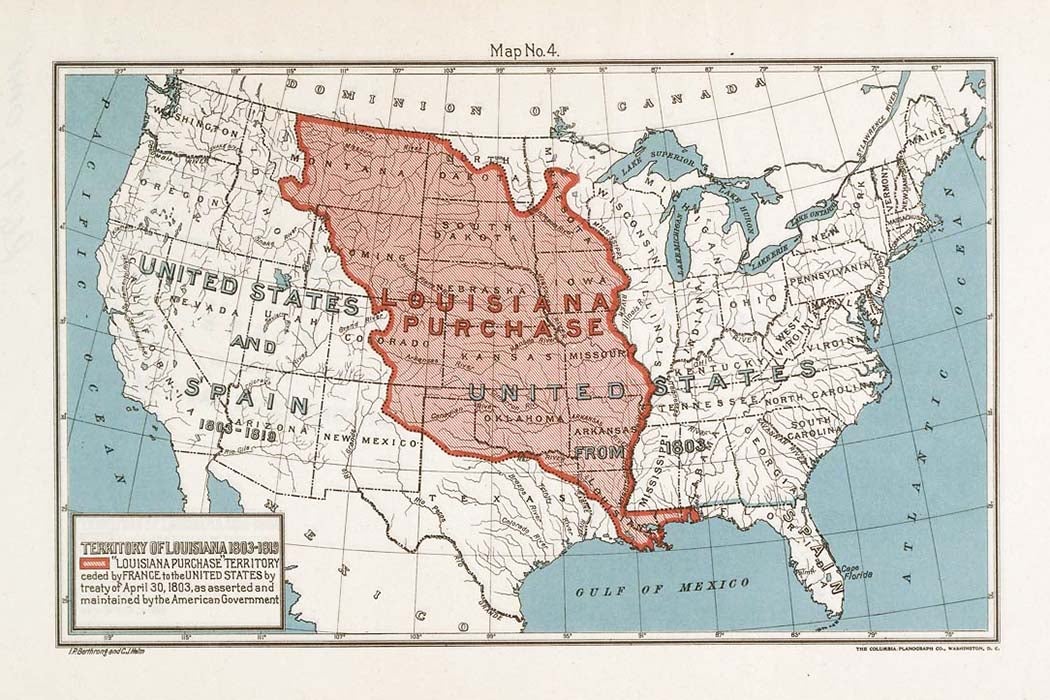It’s one of the most famous financial figures in American history. In 1803, the United States paid France $15 million for the Louisiana Territory. Henry Adams, in his 1909 history of the Jefferson administration, described the amount as “almost nothing.” At the 150th anniversary in 1953, Bernard DeVoto termed it “fantastically small.” Today, website after website translates the amount into terms everyone can understand: “4 cents an acre.”
These numbers may be the last vestige of the tradition of erasing Native Americans from American history.
Historian Robert Lee, who quotes the historians above, writes that the $15 million “has long signaled one of world history’s most spectacular real estate windfalls.” This triumphalist vision of American history obscures things, however, and quite a bit more money. Lee does the math.
The Louisiana Territory was, of course, already inhabited. Under the doctrine of discovery, what the US actually purchased from the French wasn’t title to land but the right of preemption. Preemption was the legal authority—or legal fiction, depending on how you look at it—to be the sole purchaser of land from Indigenous people in the territory. The Louisiana Purchase was therefore only the starting cost. For decades afterwards, the US purchased Native American land in the former territory, often at outrageously undervalued prices.
“A violence-backed power imbalance favored US negotiators but never eliminated Indian leverage completely, resulting in a piecemeal take over” writes Less. The result? What another historian, quoted by Lee, calls “conquest by contract.”
So how much did the US pay Native Americans for the actual land in the Louisiana Territory, not counting land taken by executive order and other non-compensated methods?
“The sheer scope of the exchange has discouraged active investigation,” writes Lee.
Hundreds of treaties, agreements, and land seizures carved chunks out of Indian country. Promises of future goods and services as consideration have prevented agreements from projecting costs reliably. Broken treaties, altered agreements, and fragmented compliance combine to make it far more difficult to assess the amount expended for Indian title.
As Lee notes, some payments were still being budgeted for in 2015: a “$30,000 appropriation for a Pawnee cession of 10 million acres made in 1857.”
To come up with a more realistic figure of the total paid to Native Americans for the Louisiana Territory, Lee dug into financial audits used in legal proceedings since 1881, when Congress passed a jurisdictional act that allowed the Choctaw sued the US in the Court of Claims. Since then, “tribes have doggedly pursued claims for economic damages caused by broken or inequitable treaties, compelling auditors to dredge up information otherwise obscured by the splintered complexity of payments.”
Indian claims cases “crested in the 1930s.” Hundreds more cases were heard after the 1946 establishment of the Indian Claims Commission. After 1978, these cases “subsided but never ceased.”
The Court of Claims rarely ruled in favor of Native Americans. When it did, “offsets” were typically deducted from the awards, reducing them as much as 90 percent, including for the cost of children “recruited”—we would say “kidnapped” or “stolen” today—into boarding schools. A seven-year study of Sioux claims over the taking of the Black Hills, for instance, listed more than $34 million (in 1931 dollars) in potential offsets to any claims awards.
Weekly Newsletter
Nevertheless, the records of these cases are troves of financial data. Tallied and mapped, the results of Lee’s forensic accounting investigation show that the “aggregate disbursements made from 1804 to 2012 for discrete Indian cessions within the Louisiana Territory” add up to $2.6 billion. This price tag “dwarfs the $15 million deal for preemption. Adjusted for inflation, the figure is comparable to roughly $418 million in 1803 dollars or more than $8.5 billion in 2012—far more than historians have thought.”
In short, it cost a lot more than what Napoleon received. Not that Napoleon made out badly: he is supposed to have thought the territory worth 50 million francs; the US paid him 60 million francs plus 20 million francs in debt relief, funding for his plans for European empire rather than a more phantasmagorical North American empire.
This, of course, is only an economic accounting, not a moral one.
Teaching Tips:
- The Louisiana Purchase Treaty (1803), courtesy of the National Archives
- A digital collection of related primary documents, courtesy of the Library of Congress
- The Indian Claims Commission Decisions, a forty-three-volume set documenting the claims of American Indian groups against the United States from 1946 to 1978
- “Louisiana Purchase Exercise,” a 1904 lesson plan inspired by the upcoming Lewis and Clark Exposition (1905), includes a recitation of the accepted price(s) for the Purchase.
Support JSTOR Daily! Join our membership program on Patreon today.







